Pickled Summer Squash Canning Recipe
This post may contain affiliate links, which means that I may receive a commission if you make a purchase using these links. As an Amazon Associate I earn from qualifying purchases.
This pickled summer squash canning recipe is perfect if you’re looking for a new way to preserve your summer squash harvest. With its tangy, slightly sweet brine, these pickled squash slices make a delicious addition to sandwiches, burgers, salads, or as a stand-alone snack.
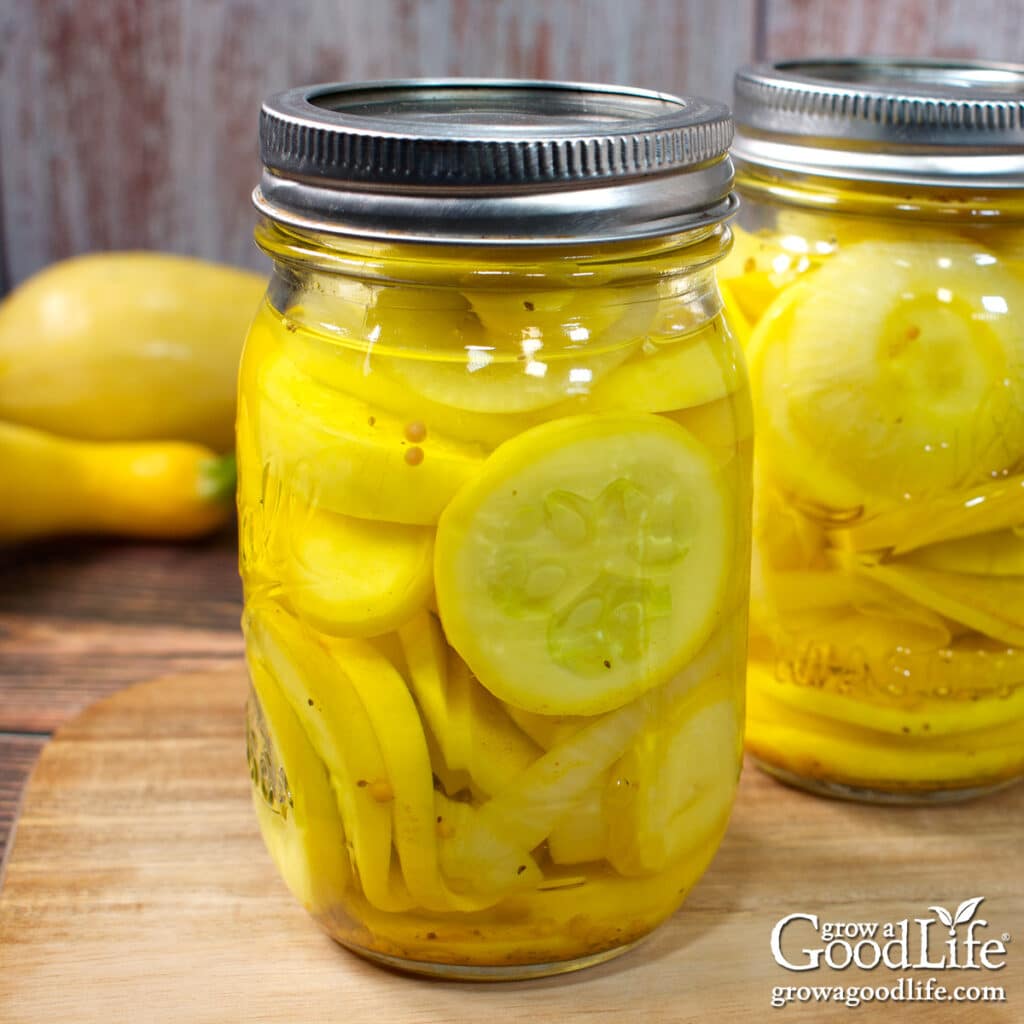
This year, I accidentally ended up with an abundance of yellow summer squash. I sowed some older seeds, unsure if they would germinate. When it seemed they weren’t sprouting, I planted a new round of fresh seeds in another part of the garden. You can guess what happened next—everything sprouted! As a result, I’ve been in a marathon trying to keep up with the harvest.
I picked the last squash I plan to use this week—enough for a meal, one more batch of summer squash relish, and the rest of the younger squash for preserving as pickled yellow squash. The plants are still healthy and will keep producing until frost. Whatever remains will be a special treat for our flock of chickens.
If you’ve overplanted summer squash this year or are simply looking for a new way to enjoy your harvest, this summer squash pickles recipe is just what you need. The tangy, slightly sweet brine gives the squash slices a delicious punch of flavor, making them the perfect condiment for your meals, either as a side dish or layered on sandwiches or burgers.

About the Ingredients
This recipe uses simple ingredients that combine to create a well-balanced pickled squash. Here’s an overview of the key ingredients:
Summer Squash: You can use any variety of summer squash, such as yellow squash, zucchini, or pattypan squash. Choose firm, unblemished squash. Young fruit is best for small round slices. Save the larger fruit for making relish.
Onion: Sliced onions bring a subtle sweetness and enhance the overall flavor. You can use red, white, yellow, or any bulb onion. Select a healthy, firm onion with no signs of rot or mold.
Pickling Salt: This draws out excess moisture from the squash, helping the pickles infuse with flavor and retain some firmness. Be sure to use pickling or canning salt, as table salt has additives that can affect flavor.
White Vinegar: White distilled vinegar ensures a tangy, sour note. But you can use any vinegar as long as it is 5% acidity, such as apple cider vinegar for a hint of fruity flavor or white wine vinegar for a milder taste.
Sugar: The sugar in the brine balances the vinegar’s acidity and enhances the pickles’ flavor without making them overly sweet.
Spices: Mustard seeds, celery seeds, and ground turmeric give the pickles their flavor and a warm yellow tint, thanks to the turmeric. Feel free to adapt the pickling spices for flavor.
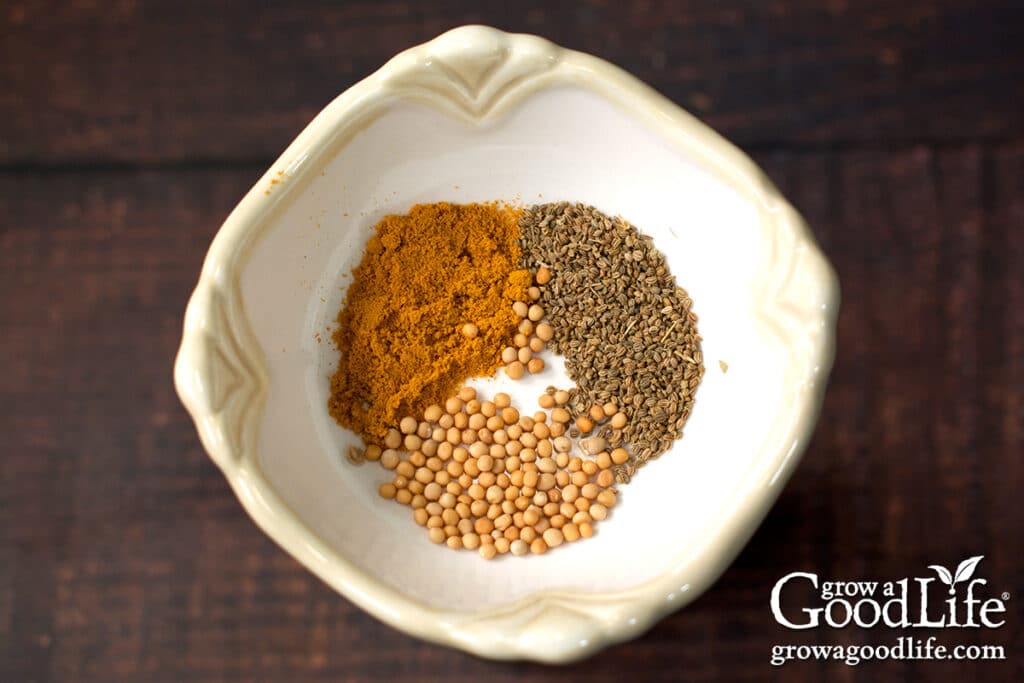
Steps for Making and Canning Summer Squash
This recipe is adapted from the “Squash Pickle Medley” recipe found in The All New Ball Book of Canning and Preserving. Before you begin, it may be helpful to go through the detailed information on using water bath canners on the NCHFP website.
You can find the complete printable recipe at the bottom of this article, but here are the detailed illustrated steps to making and canning summer squash pickles:
Step 1: Gather Your Kitchen and Canning Gear
You will need:
- Water bath canner with a canning rack
- 5 pint canning jars or 10 half-pint canning jars (yields can vary, so prep a few extra jars just in case)
- Canning lids and ring bands (new lids for each jar; bands can be reused)
- Canning tools: jar lifter, funnel, and bubble popper
- Kitchen scale to weigh the summer squash before prep
- Large stainless steel non-reactive prep bowl
- Large stainless steel non-reactive sauce pot
- Basic kitchen supplies: knife, cutting board, colander, measuring cups and spoons, ladle, and clean kitchen towels
Thoroughly wash everything in hot, soapy water. Rinse well, and set aside to air dry on clean kitchen towels until you need them. Check over the jars and eliminate any with imperfections or cracks. Pay careful attention to the rims of the jars. Minor nicks can prevent the lids from sealing.
Step 2: Prepare the Vegetables
Weigh the squash with a kitchen scale. You need 3 pounds of squash for this recipe. If the summer squash is large, you may want to remove the seeds first. Cut the squash in half, scoop out the seeds with a spoon, then weigh the squash.
Then rinse it well under running water to remove any dirt. Trim off the stem and blossom ends, and slice it into 1/4-inch rounds. Place the slices in a large bowl.
Peel the onion, cut it into 1/4-inch slices, and add it to the bowl with the squash.
Sprinkle the salt over the vegetables, cover with cold ice water, and stir to combine. Let the mixture soak at room temperature for at least 3 hours to draw out excess moisture.
If you want to break this canning project over two days, you can pop the bowl into the refrigerator and let the vegetables soak overnight.
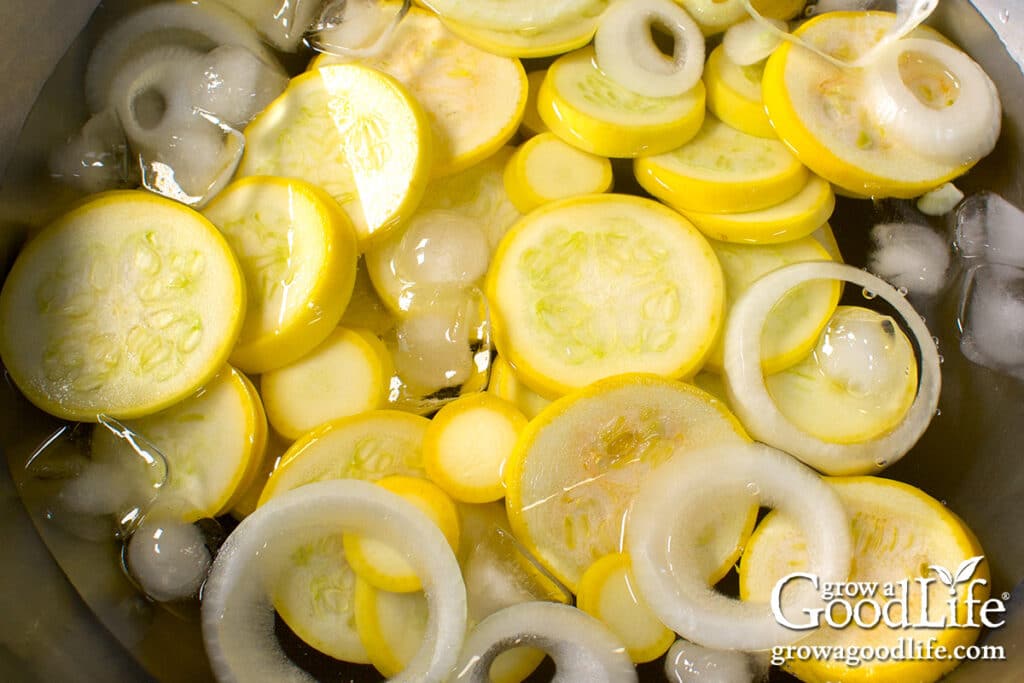
Step 3: Warm the Canner and Jars:
When you are ready to make and can your pickles, pre-heat the jars and canner. Place the water bath canner on a large burner of your stove, add the canning rack to the bottom, and place the clean jars upright on the rack. Fill the canner with enough water to cover the jars. Bring the water to a simmer (about 180°F) and keep it warm as you fill your jars.
Step 4: Make the Pickling Brine:
After soaking, drain the vegetables discarding the soaking liquid. You can rinse the vegetables to remove excess salt if desired. Set aside as you make your brine.
For the brine, combine the vinegar, sugar, mustard seeds, celery seeds, and turmeric in a large saucepan. Bring the mixture to a boil over medium-high heat, stirring until the sugar dissolves. Once dissolved, reduce the heat to a simmer to keep it warm while you fill the jars.
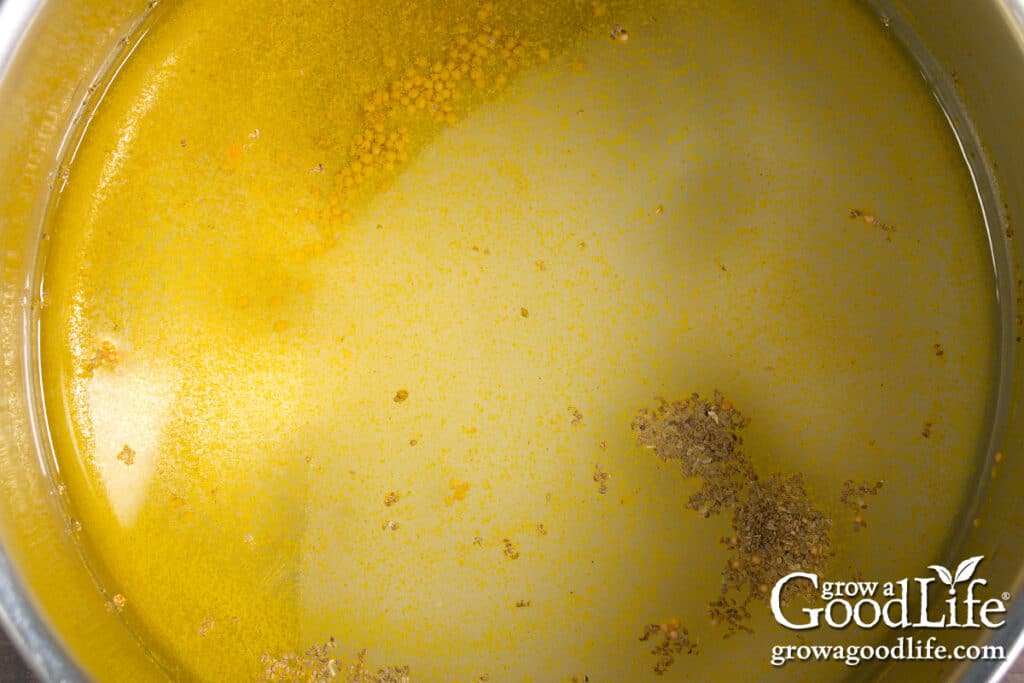
Step 5: Fill the Jars
Lay a dry towel on the counter. Using your jar lifter, remove a warm jar from the canner, draining the water back into the pot. Place the jar on the towel.
Pack the squash and onion slices tightly into the jar, leaving 1/2 inch of headspace at the top.
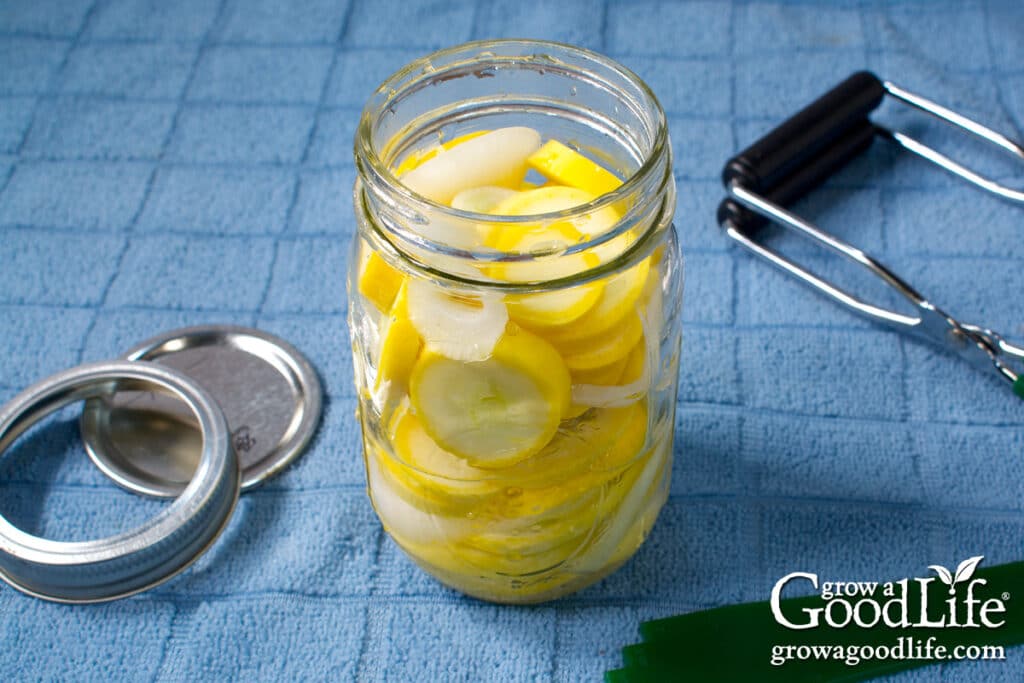
Ladle the hot pickling brine over the vegetables, making sure they are fully submerged. Leave 1/2 inch of headspace. Use a bubble popper to release any trapped air, and adjust the headspace if necessary.
Wipe the jar rim with a damp paper towel to remove any residue. Center a lid on the jar and screw on the band until fingertip tight. Return the jar to the canner and repeat with the remaining jars.
Step 6: Process in a Water Bath Canner
Once the filled jars are in the canner, adjust the the water if needed so it covers the jars by at least 2 inches. Place the lid on the canner and bring it to a rolling boil over medium-high heat.
Once the water boils vigorously, set a timer and process the jars in a water bath canner for the time indicated in the recipe below.
Step 7: Cool and Store
Once the processing time is complete, turn off the heat, remove the lid, and let the jars sit in the canner for 5 minutes to settle.
Spread a dry towel on the counter. Then, carefully remove the jars from the canner using the jar lifter, keeping them upright. Place the jars on a towel to cool undisturbed for 12 to 24 hours.
After the jars have cooled, check the seals by pressing the center of each lid. If a lid flexes up and down, the jar didn’t seal properly and should be refrigerated and used within a month.
Once you have confirmed that the jars have sealed successfully, remove the ring bands, wash, label, and store them in a cool, dark place (50-70°F). For the best flavor, let the pickles sit for 4 to 6 weeks before enjoying them. Properly sealed jars can be stored for up to 12 to 18 months.
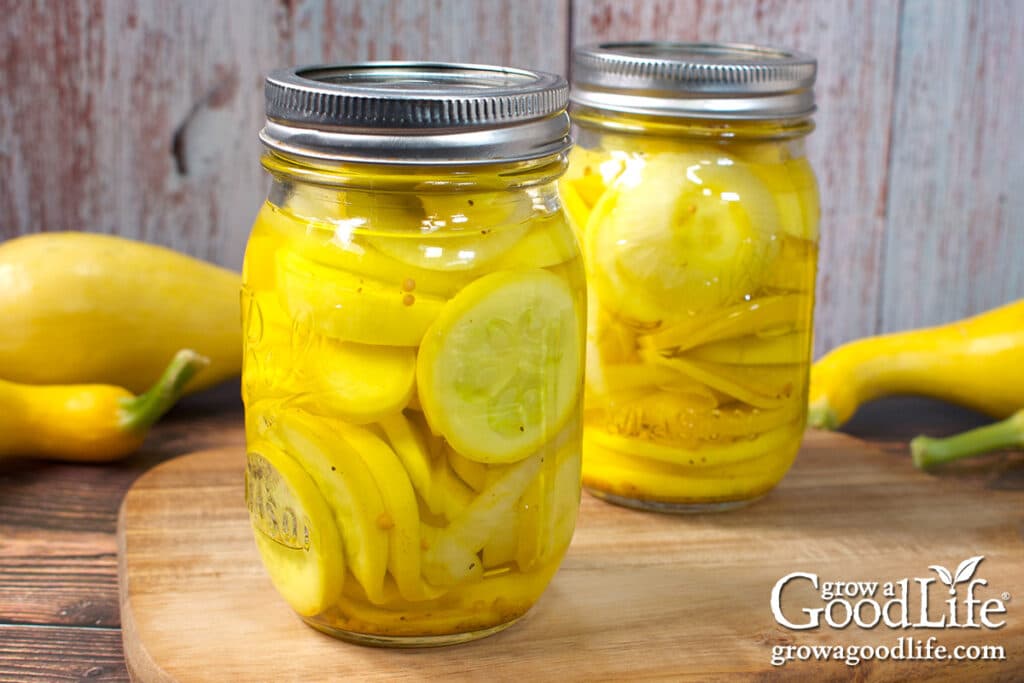
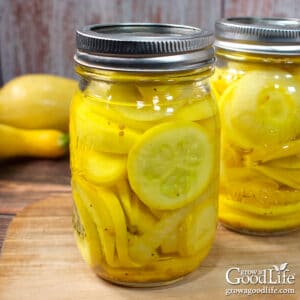
Pickled Summer Squash Canning Recipe
Ingredients
- 3 pounds summer squash any variety
- 1 small onion
- 1/3 cup pickling salt
- ice water
- 2 cups white vinegar 5% acidity
- 2 cups sugar
- 1 teaspoon mustard seeds
- 1/2 teaspoon celery seeds
- 1/4 teaspoon ground turmeric
Instructions
Prepare the Vegetables:
- Gently scrub the summer squash and rinse well under clean running water. Trim off the stem and blossom ends, cut into 1/4-inch slices, and add them to a large prep bowl.
- Peel and cut the onion into 1/4-inch slices, and add them to the prep bowl.
- Sprinkle the salt over the vegetables, then cover with cold ice water. Stir to combine, then let the vegetables soak in the salted water at room temperature for at least 3 hours.
Prepare the Canner and Jars:
- Place the water bath canner on the stove, add the jar rack, place jars upright on the rack, and add water to cover. Bring the canner to a simmer (180˚F) for at least 10 minutes, and keep warm.
Make the Pickling Brine:
- After soaking, drain the vegetables, discard the water, and set the vegetables aside. (Optional: You can rinse the vegetables to remove excess salt if desired).
- Combine the vinegar, sugar, mustard seeds, celery seeds, and turmeric in a large saucepan and bring it to a boil over medium-high heat while stirring until the sugar dissolves. Reduce the heat to a simmer, and keep warm as you fill your jars.
Fill the Jars:
- Spread a dry towel on the counter. Use the jar lifter to remove a warm jar from the canner. Drain the water back into the canner and place it on the towel. Keep the remaining jars in the canner so they stay warm.
- Tightly pack the squash and onion mixture into a warm jar, then ladle hot pickling brine to cover, leaving a 1/2-inch headspace. Run the bubble popper through the jar to release air bubbles, and adjust the headspace again if needed.
- Wipe the rim clean with a damp paper towel. Center a lid on the jar, and screw on the band until it is fingertip tight. Use the jar lifter to place the jar back into the canner, and repeat with the remaining jars.
Process in a Water Bath Canner:
- Once the filled jars are all in the canner, adjust the water level to two inches above the jar tops.
- Cover the canner and bring it to a rolling boil over medium-high heat. Once it boils, set a timer and process both pints and half-pints in a boiling water bath canner for 20 minutes at altitudes of less than 1,000 ft. Adjust processing time for your altitude if necessary. (See notes)
Cool and Store:
- When the processing time is complete, turn off the heat, remove the cover by tilting the lid away from you so that steam does not burn your face, and allow the canner to cool down and settle for 5 minutes.
- Spread a dry kitchen towel on the counter. Use a jar lifter to remove the jars one at a time from the canner. Keep the jars upright and place them on the towel. Do not tighten ring bands or test the seals yet. Let the jars sit undisturbed for 12 to 24 hours to cool.
- After the jars have cooled for at least 12 hours, check to be sure the lids have sealed by pushing on the center of the lid. The lid should not pop up. If the lid flexes up and down, it did not seal. Place the jar in the refrigerator, and use within a month.
- Remove the ring bands, wash, label, date the jars, and store in a cool, dark place between 50 to 70 degrees F for 12 to 18 months. Let the pickles sit for 4 to 6 weeks to develop flavor. Once the jar is open, refrigerate and use it within a month. Yields about 5 pint jars or 10 half pints jars.
Notes
Nutrition
You May Also Like:
- Summer Squash Relish Canning Recipe
- Dill Zucchini Pickles Canning Recipe
- Other Ways to Preserve Summer Squash
If you love salsa, consider adding our eBook, Grow a Good Life Guide to 50 Salsa Canning Recipes, to your resource library. This 72-page eBook is packed with a variety of delicious salsa recipes, including classic tomato salsas to roasted and grilled salsas to tomatillo and delicious fruit blends, all safe for water bath canning. It’s the perfect guide to help you preserve your garden harvests.

